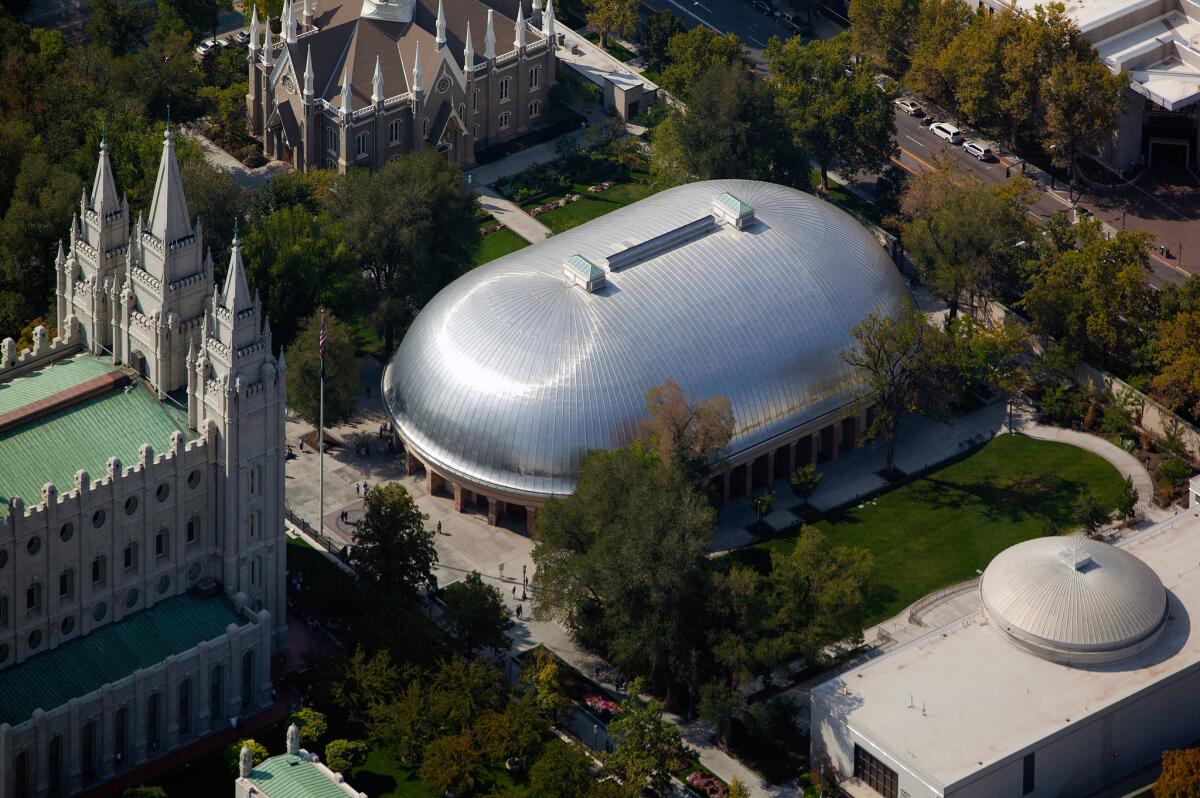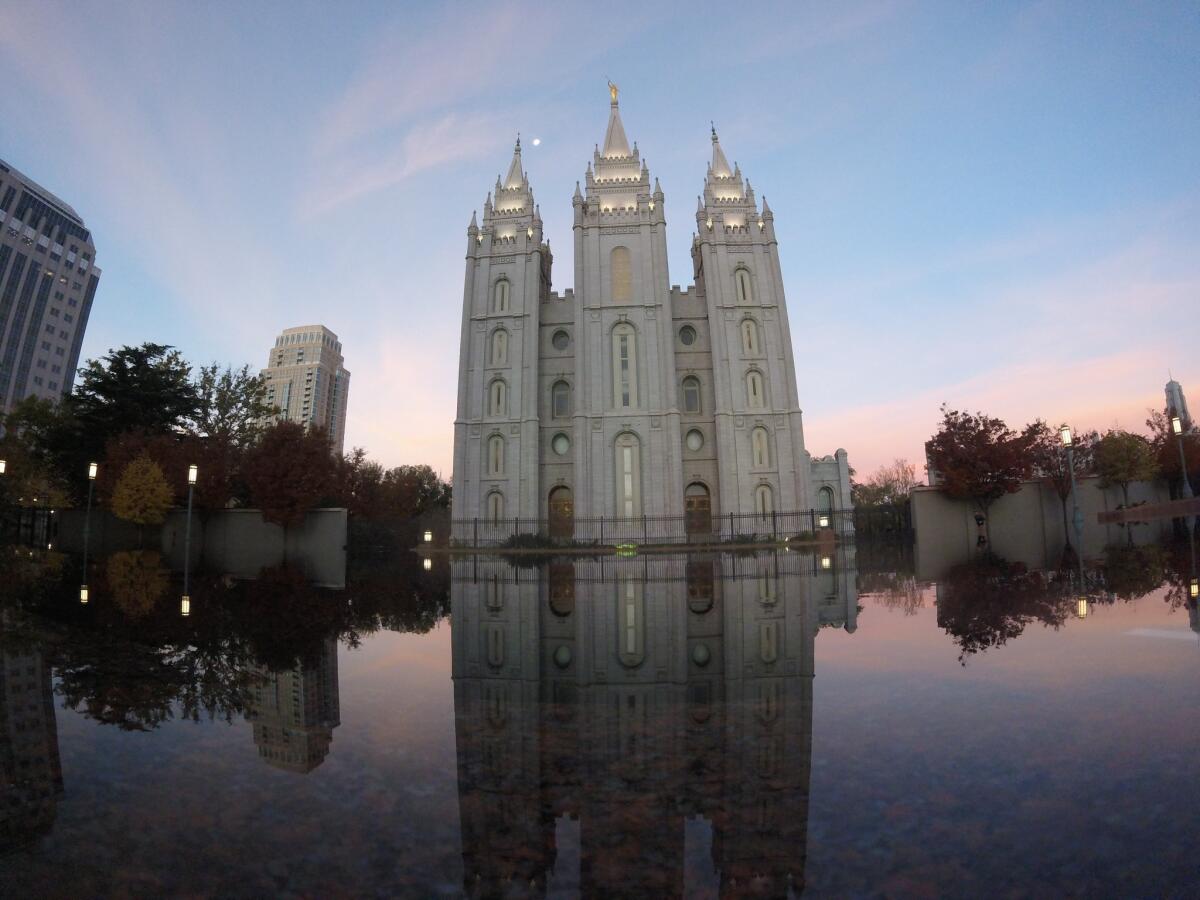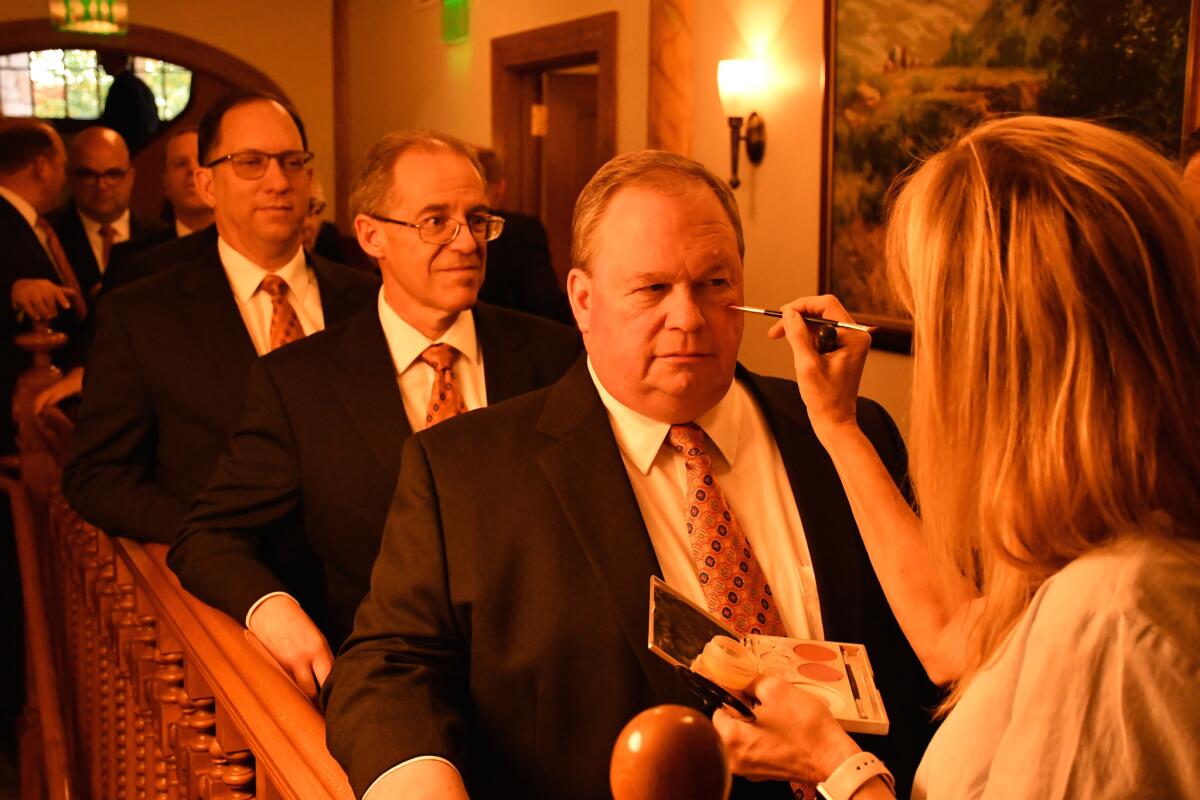In the Salt Lake tabernacle Brigham Young built, 360 voices blend with frontier history
There’s nothing particularly Mormon, or American, about “Ubi Caritas.” It’s a Gregorian chant at least 11 centuries old, was rearranged by French composer Maurice Duruflé in 1960 and has been sung by church choral groups around the world.
But I can tell you that when it is performed by a certain famous choir in a certain quirky old building in downtown Salt Lake City, that melody works a particular magic.
The voices rise and fall, singing a cappella in Latin. The sound ripples to the back of the hall, guided by the curving plaster ceiling. The final “amen” grows to 10, 15, 20 syllables, each one a slow-motion acrobat in flight.
That’s how it went on a recent Sunday morning at the Salt Lake Tabernacle at Temple Square, a singular American music venue commissioned by Brigham Young and completed in 1867.
The 360 singers who call this building home are known as the Mormon Tabernacle Choir — or rather, they were until Oct. 5, when leaders of the Church of Jesus Christ of Latter-day Saints renamed them the Tabernacle Choir at Temple Square.
In the world beyond these walls, the group has been needled for its squeaky-clean image and song list, and for performing at President Trump’s inauguration.
But the singers are a beloved avatar for the church, offering musical balm for all, backed by their own Twitter feed (since 2009) and YouTube channel (since 2012).
As for the building that houses them, one unimpressed 19th century visitor called it “a pumpkin half-buried in the sand.” To me, as light danced on its aluminum roof, the tabernacle looked like a surfacing submarine.
That shiny roof (a 1947 addition) is a great disguise for a frontier relic and a striking element among the landmark church buildings that make up Temple Square.
The site’s singular history is more than enough reason to eavesdrop on choir practice (most Thursday nights) or to see a broadcast performance (every Sunday morning) or to drop by to hear a pin drop (which happens hourly to show off the hall’s acoustics).
The choir tunes up
A Thursday night rehearsal in the tabernacle, free to the public at 7:30, is a good place to start.
Once you’re inside, look at the choir loft, where choir members will be meandering to their assigned seats, men on one side, women on the other, and making notes on their sheet music.
Chances are that music director Mack Wilberg will be up front with a microphone, delivering complaints, corrections and commendations with a dry wit.
“Ladies, you sound great,” he said. “Men, you’ve got to listen more to the ladies.”
To win a place in this group, singers must belong to the church, be at least 25, no older than 55, and live within 100 miles of Temple Square. Besides an audition, they must pass an interview and music theory test.
For the 1 in 5 applicants who makes the grade, there are hundreds of songs to learn and a year-round schedule of rehearsals, broadcasts, performances, and sometimes recording sessions and tours.
To make way for new blood, once choir members have sung for 20 years or have reached the year of their 60th birthday, they’re out.
Where we go to hear music, across the country »
Teamwork is central. Unlike a lot of show business, singing in the choir is about disappearing into a well-disciplined crowd, a priority that harmonizes with many LDS church teachings.
Oh, and there is no paycheck; all choir members are volunteers. Administration and logistics are handled by a general manager and a paid staff of about a dozen.
Meanwhile, outside Temple Square, ever-more-secular Salt Lake City (population about 200,000) offers ever more entertainment options.
The weekend of my visit, the Utah Symphony was in Abravanel Hall, the Damned were due to play the Depot, and a production of “The Rocky Horror Show” was nearing the end of its run on the Grand Theater stage.
Although the church bans the consumption of alcohol and coffee, brew pubs, coffee houses and even a few distilleries dot the city.
Nobody pictured this in 1847, when the choir first formed under church president Young. The church itself had been founded less than 20 years before by Joseph Smith in upstate New York.
Mormon pioneers had just begun settling in Utah, and the Salt Lake Valley was mostly dry and nearly empty.
Before long, Young was planning a temple (a tall, stone landmark that took 40 years to complete) and the tabernacle, which would be made of Utah pine, about 75 feet tall, 150 feet wide and 250 feet long, capped by a gently curving roof.
The tabernacle rises

Young worked with local architects and a bridge designer to craft one big room with uninterrupted sightlines and lively acoustics so a preacher’s voice could carry. That meant thinking outside the architectural box.
Young eventually chose an oval design, the roof held aloft and shaped by wooden lattice truss arches — a bridge-builder’s trick — held together by iron nails, bolts and wooden pegs above 44 stone piers.
As you walk the aisles, look closely and you’ll see that the builders painted pine columns to look like marble and disguised pine benches to look like oak. (Only in the last 20 years has the church replaced most of the pine benches with genuine oak.)
You’ll also notice the organ — an 11,623-pipe affair that towers behind the choir loft like the bow of a great ship. It isn’t the original but a descendant of one built in the 1860s, using hardware from Boston and pipes carved from more Utah pines.
“Sit in the front row and you hear the music hit you right away,” Stephanie Wood, an 18-year choir member, told me. “You sit in the back row and it feels like it wraps around the building before you hear it.”

Wood sings alto. In the choir loft, she said, there are spots “where you can’t hear really at all. You sit there and you think, ‘I’m singing by myself.’ But you know you’re not.”
The building “just oozes history,” said Matt Harmer, a 54-year-old attorney and father of seven who started singing baritone with the choir this year.
Harmer said he had worried that singing would cut into his skiing, rock-climbing and hiking, but the first time he stood in the tabernacle to sing “Come, Come Ye Saints,” a hymn from the church’s early days, he realized he had chosen well.
“It was very emotional,” he said, “just to have a chance to sing this song that has meant so much to so many people in this faith, in this building that people sacrificed so hard to build.”
Most visitors don’t get invited to climb into the rafters, but if you could (or if you peek at my video), you would see 21st century seismic upgrades alongside rawhide skins, which the pioneers tied around split planks to strengthen them. You would also see thousands of organ pipes, mostly clustered above the stage.
The day I watched, organist Linda Margetts dropped three pins, one by one, and then a nail to show how freely sound travels
Some, known as pioneer pipes, date to the building’s first days and stand as tall as 30 feet, producing tones that seem more seismic than sonic.
And if an organist should start to play loudly while a newcomer is climbing around those pipes — well, let’s just say that for a few moments during my exploration with master keyboard technician Robert Poll, death by bass note seemed a real possibility.
For a less rattling introduction to the building’s acoustics, visitors need only stop in for the tabernacle’s free daily organ recital (noon Mondays-Saturdays, 2 p.m. Sundays). The pin-drop demonstrations also take place, typically every hour on the hour, 9 a.m. to 9 p.m.
The day I watched, organist Linda Margetts dropped three pins, one by one, and then a nail — which resounded like a rifle shot — to show how freely sound travels about 170 feet from the stage to the back row.
Then Margetts played, her hands dancing among the instrument’s five keyboards, then pausing while her feet worked the pedals. At one point, tapping out 16th-note triplets, she looked like an Irish dancer, arms at her sides, feet flying.
That was a spectacle I hadn’t expected. But I still hadn’t experienced the full tabernacle choir.

For that, you need an evening performance or a Sunday morning broadcast of the show that made the choir famous.
Lights, camera, choir
“Music & the Spoken Word,” a 30-minute mélange of song, organ music and inspirational narration, began as a radio show in 1929.
By 1949, the choir, which had been recording for decades, was releasing its first commercial album on Columbia Records. By the 1960s, the broadcast was televised, and the choir was singing for presidents, touring the world, and working with the New York Philharmonic and the Philadelphia Orchestra.
More recent collaborators have included Audra McDonald, Yo-Yo Ma, James Taylor and most recently Kristin Chenoweth, who joined this year’s holiday shows.
On my Sunday morning, I found the choir members decked out in formal wear (men in dark suits and ties, women in beige gowns).

The tabernacle’s benches, typically arranged to hold as many as 3,000 listeners, were about two-thirds full. A church hostess warmed up the crowd and welcomed groups from Ecuador, Myanmar and Taiwan — reminders of the church’s global recruitment efforts.
After the countdown to open the broadcast, a narrator welcomed us in fatherly tones and organist Richard Elliott leaned over the keyboards.
Meanwhile, a sophisticated lighting system threw intense colors onto the curving wall behind the choir — sometimes blue, sometimes purple, sometimes red, which made the gold-leaf organ pipes glow like flames.
Several hymns, folk songs and other pieces followed, including “Ubi Caritas.”
In the morning’s spoken interlude, narrator Lloyd D. Newell reminded us that 1.) you shouldn’t let other people’s social media feeds get you down and 2.) “fun and happiness are not the same thing.”
Edgy it was not. But those 360 voices, raised together, were something to hear. I eventually spotted Wood among the altos and Harmer with the baritones.
“I know there are a lot of people who enjoy doing stage productions and they like doing solos, and that’s never been my forte,” Wood had told me. “I have always loved being one of many in creating an amazing sound.”
“You don’t want 360 soloists,” Harmer had said.
In no time, the broadcast was winding up. It ended with the choir’s voices on “God be with you till we meet again” — predictable, perhaps, but warm and comforting on a winter day.
If you go
THE BEST WAY TO SALT LAKE CITY
From LAX, American, Delta, United and Southwest offer nonstop service to Salt Lake, and Southwest, United, Delta and Alaska offer connecting service (change of planes). Restricted round-trip airfare from $163 round trip, including taxes and fees.
WHERE TO LISTEN
The Tabernacle, 50 West North Temple, Salt Lake City; (801) 240-2534. The Tabernacle, usually open 9 a.m. to 9 p.m. daily, is part of Temple Square, a 35-acre area that also includes the Salt Lake Temple, two visitor centers and free tours. Besides choir rehearsals (7:30 p.m. Thursdays), the Tabernacle offers free admission for Bells on Temple Square rehearsals (7:30 p.m. Wednesdays); daily organ recitals (noon Mondays-Saturdays, 2 p.m. Sundays); and live broadcasts of the choir’s 30-minute “Music & the Spoken Word” program (8:30-10 a.m. Sundays ).
WHERE TO STAY
AC Hotel, 225 West 200 South, Salt Lake City; (385) 722-9600. Doubles at this Marriott affiliate start at $158.
Kimpton Hotel Monaco, 15 West 200 South, Salt Lake City; (801) 595-0000. Stands a few blocks from Temple Square and the lively City Creek mall. Doubles from $190.
Holiday Inn Express, 206 South West Temple, Salt Lake City; (801) 521-9500. Basic downtown lodging convenient to convention center and Temple Square. Doubles from $139.
WHERE TO EAT
Pretty Bird, 146 S. Regent St., Salt Lake City. This tiny spot specializes in Nashville-style fried chicken, and the heat comes in four strengths, from mild to very hot. Main dishes $9.50-$15.
Boltcutter, 57 E. Gallivan Ave., Salt Lake City. This vegan Mexican restaurant, which has a short menu, busy dining room and full bar, opened in 2017. Expect hipsters in the house. I liked the Cali Burrito. Main dishes $9-$12.
Campos Coffee Roastery & Kitchen, 228 S. Edison St., Salt Lake City; (801) 953-1512. This breakfast and lunch spot is packed on weekends – especially Sundays, when most of Salt Lake City is locked up tight. Main dishes $8-$15.
Nauvoo Café, Joseph Smith Memorial Building, Temple Square; 15 East South Temple, Salt Lake City; (801) 539-3346. Casual snack stop for sandwiches, salads and turkey pot pie. Most dishes $4-$8
TO LEARN MORE
Follow Reynolds on Twitter: @MrCSReynolds
Sign up for The Wild
We’ll help you find the best places to hike, bike and run, as well as the perfect silent spots for meditation and yoga.
You may occasionally receive promotional content from the Los Angeles Times.




